

![]()
HERDING DOGS OF WESTERN EUROPE

Above, a Castillan Shepherd Dog herding a mixed flock of sheep and goats in Alhambra in south-central Spain.
(Photo by Pablo León, courtesy of Federico Casillas.)
THE HERDING DOGS OF SPAIN
During the Middle Ages, the Royal Council of the Mesta controlled the great flocks of sheep that were driven from the pastures of Extremadura (in the central plains) to Castile (in the northern mountains) and back again according to season. The Mesta was a powerful association of sheep owners in the medieval Kingdom of Castile. Owners of migratory flocks hired shepherds from the mountains who knew the terrain for the transhumance. Dogs were not used for this purpose, and were in fact prohibited, except for livestock guardian breeds.
Today, Spain, as compared to other European countries, has less land devoted to agriculture, due to many factors, including climate, how mountainous it is, industrialization bleeding off the rural workforce, and so on. Sheep production seems to still be the largest sector of the livestock industry, with most of the sheep being raised in the Ebro basin in north-central Spain. In 2011 shepherds brought 5,000 sheep and 60 cattle into Madrid, crossing the city to exercise their right to droving routes that have existed since 1273 AD that are today threatened by urban sprawl. It appears that Madrid is in the way of two north/south routes, one dating back to 1372. Madrid was a rural hamlet then, only becoming a capital city in 1561 when King Philip II moved his court there. The trek indicated that transhumance is still alive, at least in part of Spain, where increasingly, modern farming methods are confining sheep to barns.
Galician Farm Dog or Can de Palleiro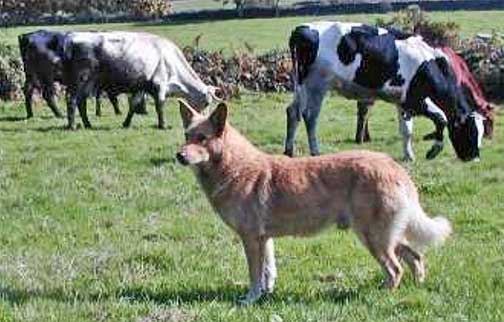
A typical Gallician Farm Dog (Can de Palleiro) with dairy cattle.
(Photo courtesy of Club Can de Palleiro and Xosé Manuel Vales.)
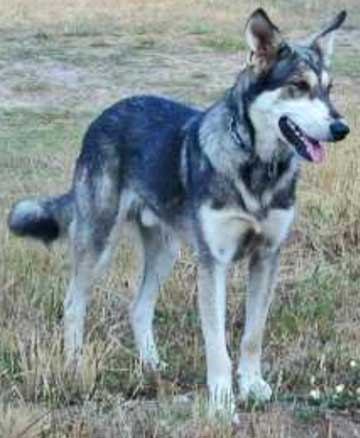
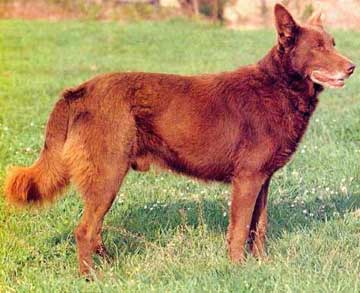 Left, a saddle-patterned and right, a solid red. (Photos courtesy of Xosé Vales.)
Left, a saddle-patterned and right, a solid red. (Photos courtesy of Xosé Vales.)
The Can de Palleiro hails from Galicia in the northwest corner of Spain north of Portugal. It is a little bigger than most of the other dogs we have been considering, measuring around 22 to 24 inches at the shoulder, but still considered a medium-sized dog. Its name means "dog of the straw-loft", for there is where it's early ancestors slept, guarding the barn and homestead; but it has been called by many names, including shepherd, cattle dog, house dog, and barn dog, and it has fulfilled all of these roles and more as a general purpose farm dog. The Can de Palleiro is known as the "Celtic shepherd" in Spain, according to Alberto Bertelli, "because it seems its presence [was] established with the pre-Roman Celtic-Iberian populations" though others say that its ancestors were the dogs of the peasants of Central Europe and accompanied pre-Celtic people into Spain. It is also said that it shares a common ancestry with the Belgian sheep dogs, the French Picardy, and others. It is still used by cattle and dairy farmers throughout Galicia today, but it is in danger of extinction due to its limited numbers. A club of enthusiasts is struggling to preserve the breed. According to Xosé Vales of the Club Can de Palleiro, there are only 400 dogs extant and 1,000 are needed for recognition from the FCI, which they do mean to seek.
In color, the Palleiro comes in all shades of sable, saddle-patterned sable, wolf, solid tan (called sand), solid red (called cinnamon), and even black, sometimes with white markings.
Below, a black Can de Palleiro guarding his flock. (Photo courtesy of Xosé Vales.)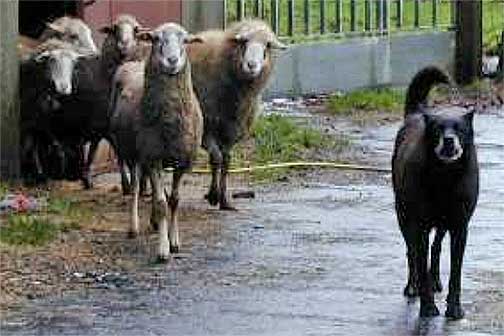
Basque Shepherd Dog or Perro de Pastor Vasco or Euskal Artzain Txakurr
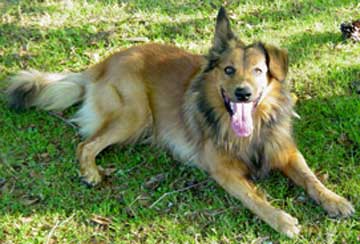
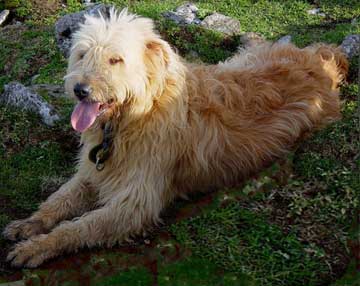 Left, a Basque Shepherd Dog known as a Gorbeikoa or moderate rough coat and right, a Basque Shepherd Dog known as an Iletsua or bearded variety. (Photos from Elexartza courtesy of Eduardo Pastor.)
Left, a Basque Shepherd Dog known as a Gorbeikoa or moderate rough coat and right, a Basque Shepherd Dog known as an Iletsua or bearded variety. (Photos from Elexartza courtesy of Eduardo Pastor.)
Called Euskal Artzain Txakurr (shepherd dog) in Basque, the Pastor Vasco is one of the oldest herding breeds. Adherents trace it to the Neolithic. Remains of dogs were found dating to 12,000 years ago in the Basque region, however it is impossible to currently say they were of one breed or another, or that the current Basque Shepherd Dog is descended from them. Go forward 10,000 years, and a more reliable claim may be made for having found evidence of Pastor Vasco in medieval pastoral ordinances, and in frescoes and paintings of the 16th century.
The Pastor Vasco comes in two varieties, a moderate rough coat called the Gorbeikoa and a moderately bearded type called the Iletsua (which means "hairy" in Basque). Both are medium-sized dogs, sable with a black mask. The Gorbeikoa is thought to be the older of the two. According to Linda Rorem, both are noted for their "rustic constitution and temperament" and their "excellent talent for herding sheep, cows, horses and even chickens". They are traditionally found herding the sheep flocks of all of the mountainous Basque region of northern Spain.
The Pastor Vasco became endangered in the late 19th, early 20th centuries, not due to a loss of grazing lands or diminished need for driving sheep long distances, but because of an increase of wolf attacks on the flocks, probably owing to a loss of wolf habitat elsewhere. Shepherd dogs were replaced by livestock guardian types, and in those places the Pastor Vasco began to decline. However, in some places, changes in grazing patterns and alertness of villagers allowed sheep to be pastured more safely and there the Pastor Vasco survived. In 1995 the Pastor Vasco was officially recognized by the Royal Canine Society of Spain. Despite its new status, it is claimed that nearly all registered dogs work indigenous livestock daily.
León Shepherd Dog or Carea Leonés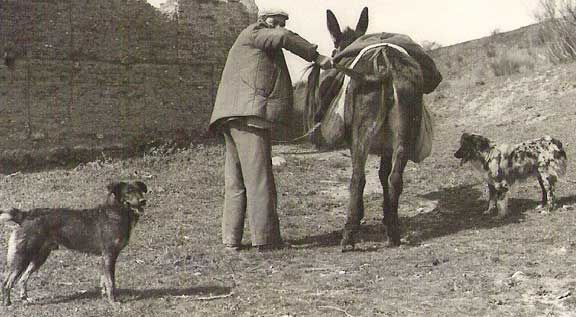
An old photo of a shepherd from León with a donkey and two Careas.
The one on the right is merle and looks as if it might be bob-tailed either naturally or docked.
(Photo in the public domain.)
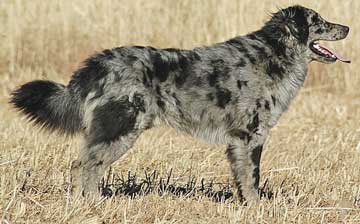 Left, a blue merle Carea Leonés and below right, two black-and-tan Carea Leonés. (Photos courtesy of José Moran.)
Left, a blue merle Carea Leonés and below right, two black-and-tan Carea Leonés. (Photos courtesy of José Moran.)
The Carea Leonés, also called Pastor Leonés, is a medium-sized herding dog from Castile and León in north-central Spain whose development coincided with the dissolution of the Royal Council of the Mesta (1836) and subsequent decline of transhumance. At that time, many shepherds established farms of their own. The grazing system that developed is called transterminance: flocks are grazed among agricultural lands near villages during winter months, and driven to nearby higher pastures in summer. This system had been in use in the northern Iberian Peninsula from pre-Roman times, and it is assumed that Carea-type dogs were in use then as well. Hard dogs willing to bite were preferred by shepherds of León to keep livestock out of crops, and they were perfectly adapted to long journeys and harsh conditions in the mountains as well. Dogs that could not live up to severe conditions and expectations of shepherds were bred out and those left became the ancestors of the Carea Leonés.
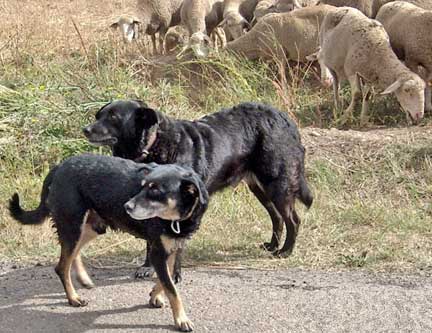 During the Spanish Civil War (1936-1939), these dogs actually proliferated, as their help was needed due to a shortage of shepherds who went to fight in the war. However, as small farms began to vanish in the mid-20th century, so the Carea began to dwindle. Currently, seasonal movement of cattle, and to a lesser extent, sheep, still takes place on foot in Spain for the Spring/Summer migrations. Return to winter pastures, however is often done by truck. This may be more convenient, but the down side is that the purpose for maintaining cattle routes disappears, and routes deteriorate over time, making foot travel even more difficult. It may also affect the number of dogs needed. Today there are fewer than 500 Careas known in the county of León. The breed is not recognized by any kennel club and there is no standard; but there is a Leonese Canine Society supported by breeders, fans, and shepherds, working to maintain and perpetuate the breed. The Carea is solely a working dog, but some owners have begun to compete in agility and search-and-rescue with their dogs.
During the Spanish Civil War (1936-1939), these dogs actually proliferated, as their help was needed due to a shortage of shepherds who went to fight in the war. However, as small farms began to vanish in the mid-20th century, so the Carea began to dwindle. Currently, seasonal movement of cattle, and to a lesser extent, sheep, still takes place on foot in Spain for the Spring/Summer migrations. Return to winter pastures, however is often done by truck. This may be more convenient, but the down side is that the purpose for maintaining cattle routes disappears, and routes deteriorate over time, making foot travel even more difficult. It may also affect the number of dogs needed. Today there are fewer than 500 Careas known in the county of León. The breed is not recognized by any kennel club and there is no standard; but there is a Leonese Canine Society supported by breeders, fans, and shepherds, working to maintain and perpetuate the breed. The Carea is solely a working dog, but some owners have begun to compete in agility and search-and-rescue with their dogs.
The Carea comes in three color patterns: solid black (negro), black-and-tan (called "four-eyes" because of prominent eye-spots), and blue merle (called "harlequin" or pinto, but it is neither harlequin nor pinto), all with no or varying amounts of white on chest and legs. Coats can be smooth or medium rough and wavy, with semi-erect ears and a long tail. The Carea can herd any type of livestock, including cattle, horses, and large flocks of sheep. They are loose-eyed, upright workers, but it appears that some have a small degree of eye. When the flock is on the move, sheep are conditioned to follow the shepherd. The dogs walk alongside or behind the shepherd, in front of the sheep, but dash to the sides or back whenever the shepherd directs them to, and when the sheep need extra incentive to move, grip is available to them. They are silent workers. The shepherd and dogs remain with the flock as they graze and seem to be constantly in motion, keeping the flock moving from one grazing area to another and keeping them out of crops. Often a livestock guardian dog accompanies the flock but does not interfere with the herding dogs.
Castilian Shepherd Dog or Perro Carea Castellano Manchego
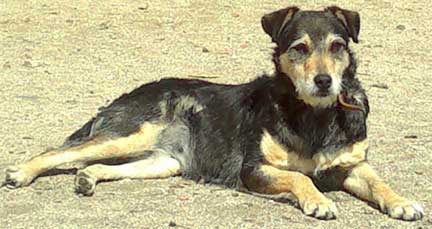
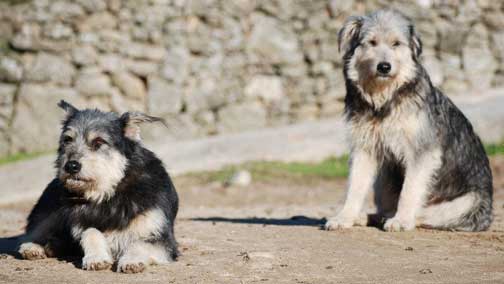 Left, a smooth-coated Carea Castellano Manchengo and right, two bearded Castellanos. (Photos by Pablo León, courtesy of Federico Casillas.)
Left, a smooth-coated Carea Castellano Manchengo and right, two bearded Castellanos. (Photos by Pablo León, courtesy of Federico Casillas.)
Castile-La Mancha is an autonomous community of Spain located in the central area of the country. The southern portion of this area is the historical region of La Mancha, located on an arid, fertile, elevated plateau, the largest plain in the Iberian Peninsula. Large flocks of dairy sheep and goats are raised there, and the sheepdog of the area is the Perro Carea Castellano Manchengo or Castilian Shepherd Dog. There is very little information available on this breed, and although there are large flocks in La Mancha, the Carea Castellano's numbers are dropping. It is a medium-sized breed that comes in a bearded, or more probably, a wire-haired variety and a smooth-coated variety. Their color is black and tan or blue and tan. They are capable of herding large flocks of sheep.
Catalan Sheepdog or Gos d'Atura Català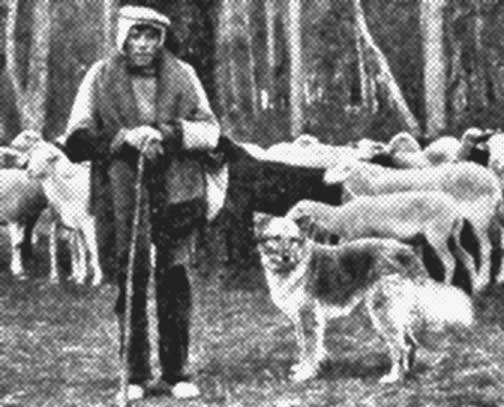
Above, an old photo of a Catalonian shepherd with a moderate
rough-coated Catalan Sheepdog. (Photo from von Stephanitz.)
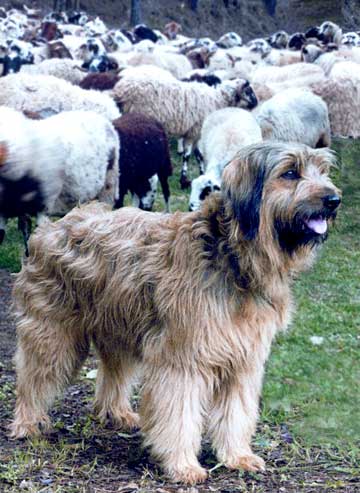
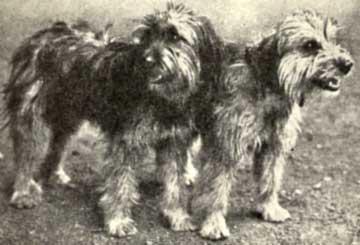 Left, a bearded Catalan Sheepdog with a flock of sheep. (Photo courtesy of Jordi Jordana.)
Left, a bearded Catalan Sheepdog with a flock of sheep. (Photo courtesy of Jordi Jordana.)
Right, an old photo of two bearded Catalan Sheepdogs from von Stephanitz shows that the breed has not changed much in nearly a hundred years.
Andorra is an independent principality in the Pyrenees Mountains, on the border between France and Spain. Catalan or Catalonia is an area in northeast Spain that borders on France and Andorra. The Catalan Sheepdog or Gos d'Atura (Andorra) Català is a medium-sized dog similar to the Câo Da Serra (Portuguese Sheepdog), the Bearded Collie, the Old English Sheepdog, or a number of other European bearded dogs. It comes in two coat varieties: a long bearded double coat and a moderate rough coat, both of which come in fawn (recessive yellow), sable with a black mask, or shades of grey (possibly merle). There used to be a smooth variety, but it may have gone extinct. There are also two named separate varieties, the Gos d'Atura de Cerdanya, which is slightly larger than the Català, and the Gos d'Atura Aranès, which may have originated in the French Berger des Pyrénées. The Catalan's history, like that of most European breeds, is traced back to the Romans by devotees. Whether true or not, the Catalan is an old Spanish dog bred from old Pyrenean shepherd dogs, that were used on farms in Catalonia to drive livestock and guard the flocks. In 1948, a working dog competition was begun which still takes place in Catalan which has popularized the breed.
The Catalan saw a rapid decline in the 1950s and '60s as people moved from rural areas to towns and many farms were abandoned. In the 1970s a recovery took place when the Dog Fancy took an interest in the breed and bought dogs from shepherds who were still using them (and still use them today) for flock control. During the Spanish Civil War, dogs of this breed served as messengers and sentries. This breed may be slightly better known than some of the other breeds presented here, as Catalan Sheepdogs have appeared in the films 101 Dalmatians, 101 Dalmatians II, and Back to the Future; but it is considered a Rare Breed in some countries nevertheless. The Catalan is registered with the FCI.
Herreño Wolf Dog or Perro Lobo Herreño
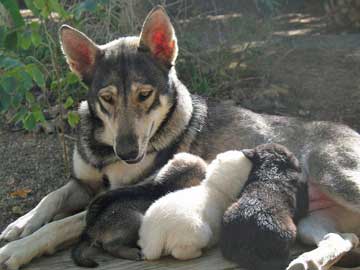
A Perro Lobo Herre–o nursing her three pups.
Notice the pup in the middle is almost white, probably a "fawn".
(Photo courtesy of Angela Galan.)
The Canary Islands lie off the northwest coast of Africa. The name is likely to have derived from the Latin name Insula Canaria, which means "Island of the Dogs". Thirteen islands make up the archipelago, which is a Spanish autonomous community. There are many theories as to why the name Islas Canarias was given to these islands, some of which involve the Romans finding many dogs there when they first arrived, to the presence of seals, "the dogs of the sea" (the Latin name for Monk Seals is canis marinus--"sea dog"--a species that is critically endangered and no longer present in the Canary Islands).
The original inhabitants of the islands were called Guanches. The term guanchinet literally means "person of Tenerife", the largest of the islands. They were a group of aboriginal Berbers (DNA evidence and what remains of their language point to a relationship to the Berbers) believed to have migrated from North Africa to the archipelago sometime between 1,000 and 100 BC or earlier. They lived in relative isolation before the Spanish colonization (1402-1496), Tenerife being the last to fall. The Guanches worshiped dogs, mummified them and treated them as holy. This implies that dogs were present in the Canaries prior to the Spanish conquest, and indeed, the chaplains accompanying the Conquistadors wrote about the presence of "wild dogs like wolves, but they are small". It is not known (yet) whether dogs found on Tenerife and those found on Gran Canaria (see below) had a common origin. The coat of arms of the Canary Islands reflects its connection to dogs.
The Perro Lobo Herreño, like other endangered breeds of herding dog, has a group of enthusiasts working to preserve the breed. The breed gets its name from the island of El Hierro, where the Association for the Recovery of the Wolf Dog is studying it. The dogs range in size from 20 to 21.5 inches, males being somewhat larger than females. They come in grey (wolf or agouti or grey sable), which is the characteristic color, but also red, with a few individuals of white or cream (tan? or dilute red?). Most have a light mask. Their coats would be considered "moderate rough". They were used primarily as cattledogs, sheepdogs, guardians, general farm dogs, and also to keep the livestock out of crops. It is claimed by some that this breed is the result of hybridization with wolves, but the study disputes this, as DNA sequences prove otherwise. However, looks and behavior would indicate a closer relationship to the wolf than many other herding breeds. Some breeders on other islands have crossed the Perro Lobo with Border Collies and other breeds, but the population on El Hierro is pure, and the Association hopes to keep it so. Unfortunately, currently, due to the disappearance of grazing, their job has become obsolete and the Association is introducing them as companions and for dog sports. There is no doubt that a registry and petition to FCI for recognition will follow, but that has not yet happened.
Pastor Garafiano or Perro de Pastor Garafiano
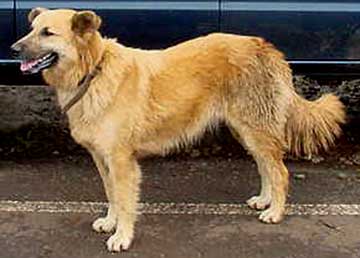
Above, a Pastor Garafiano.
(Photo courtesy of Alan and Barbara Buck.)
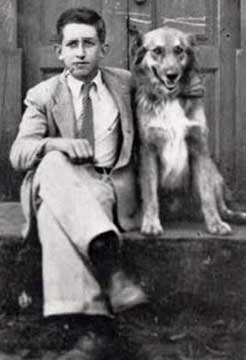
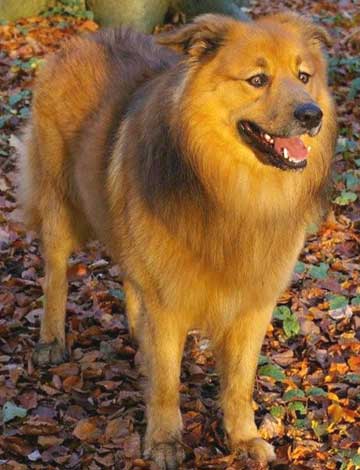 Left, an old photo of a man from Gran Canaria with his Pastor Garafiano dog. (Photo courtesy of El Pastor Garafiano website.)
Left, an old photo of a man from Gran Canaria with his Pastor Garafiano dog. (Photo courtesy of El Pastor Garafiano website.)
Right, a Pastor Garafiano. (Photo courtesy of Alan and Barbara Buck.)
The Pastor Garafiano, the herding dog of Gran Canaria, the third largest island in the Canaries, has been called "the Spanish Collie". It is a bigger dog than most we are talking about, being between 21 and 25 inches, and has been used mostly to gather goats in the mountains.
These dogs are considered to be descendants from cross-breeding with dogs brought by Spanish colonials in the 15th century. When the GSD and other breeds were introduced in the islands in the 1960s, crossing with the Garafiano produced a dog that was aggressive and hard on sheep and goats, and the original type was in danger of extinction. Efforts have been made to restore the breed to its original type.
The Garafiano is a beautiful, rough-coated dog with prick ears and a long tail. It gets cold in the mountains of Gran Canaria in winter, and there is usually snow, so these dogs need thick, double coats, as the dog at right has. They come in recessive yellow or sable, with or without a black mask. White points that appear on pups usually disappear with age. The Garafiano has been recognized in Spain and today can be seen in dog sports and show, and there are still Garafianos working in the mountainous regions of the islands.
Majorca Shepherd Dog or Perro de Pastor Mallorquin
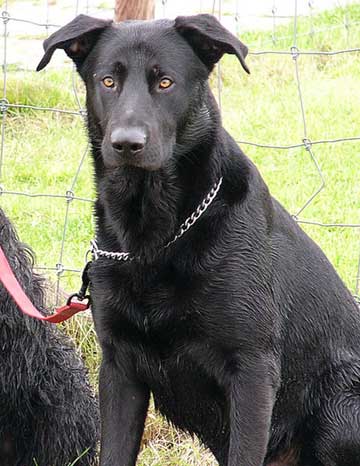 Left, a Majorca Shepherd. This dog has a smooth coat, but there is a dog next to him that can hardly be seen that has a wavy rough coat. (Photo from Wikipedia where the copyright holder of this work published it under the terms of the GNU Free Documentation License.)
Left, a Majorca Shepherd. This dog has a smooth coat, but there is a dog next to him that can hardly be seen that has a wavy rough coat. (Photo from Wikipedia where the copyright holder of this work published it under the terms of the GNU Free Documentation License.)
Like the Canary Islands, the Balearic Islands are an archipelago, and an autonomous community and province of Spain. They are in the western Mediterranean Sea near the eastern coast of the Iberian Peninsula. Majorca is the largest island. The language spoken there is Catalan. Like many of the European sheepdogs, the Majorca is both a herding dog and a guardian, and its size reflects this. It can be up to 28 inches and 80 pounds. Still, it is considered a medium-sized dog and although it is bigger than most of the dogs we are discussing here, it is worth mentioning to illustrate that Spain's islands each have their own type, adding to the diversity of Spanish herding dogs.
The Perro de Pastor is, for the most part, unknown outside Spain, although it is recognized by the FCI. It is quite common in Spain on farms and in rural villages. It has the temperament of a guardian dog and is very territorial. Solid black is the predominant color, and most are smooth-coated and have evolved to withstand extreme heat. There is also a rough-coated variety with a wave to the hair on the back. The breed is thought to have been brought to the Belearics via early Mediterranean trade routes where it developed by crossing with various other indigenous dogs.
Thanks go to the following people for their invaluable help:
Alberto Bertelli, Alan Buck, José Luis Prieto Morán, Linda Rorem, and Xosé Manuel Vales
Copyright ©2014 by Carole L. Presberg
Resources:
Bertelli, Alberto. Department of Zoology, Parma University, Northern Italy, from private correspondence.
Club de Raza Can de Palleiro (www.clubcandepalleiro.com/)
Elexartza (www.elexartza.blogspot.com.es/2010/04/euskal-artzain-txakurra.html).
El Pastor Garafiano (www.garafiano.com)
Gos d'Atura Català (www.rac.uab.es/gosdaturaang.htm)
La Maison de la Transhumance (www.transhumance.org).
Rorem, Linda, "The Way They Work" on Herding on the Web (www.herdingontheweb.com/workingstyles.htm).
Vales, Xosé Manuel. From private correspondence.
Von Stephanitz, Capt. Max. The German Shepherd Dog, originally published ca. 1918 in German; 8th edition published in German in 1932; English edition of 8th edition published 1947, published by Verein für deutsche Schäferhunde.
Wikipedia: Can de Palleiro (en.wikipedia.org/wiki/Can_de_Palleiro).
Wikipedia: Carea Leonés (en.wikipedia.org/wiki/Carea_Leon%C3%A9s).
Wikipedia: Catalan Sheepdog (en.wikipedia.org/wiki/Catalan_Sheepdog).
Return to
![]()
BORDER COLLIE COUSINS
THE OTHER WEB PAGES WE MAINTAIN
These web pages are copyright ©2013
and maintained by webmeistress Carole Presberg
with technical help from webwizard David Presberg
ALL RIGHTS RESERVED
If you are interested in using ANY material on this website, you MUST first ask for permission.